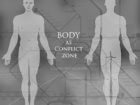Body as a Conflict Zone
“Physical violence is a process through which power and powerlessness are inscribed on and through the body” (Lucy Nevitt, 2013, Theatre and Violence, ed. Palgrave Macmillian, Hampshire)
When physical violence is applied to a person, this person ceases to exist as a human being and exists only through the pain occurring in his or her body. The pain takes over the being and brings forwards the physicality of the body. If a victim is tortured by letting him/her starve, all the thoughts and actions of that person go towards the necessity of having food. The belly, the part that is negated by denying food becomes the center of everything. The subjectivity of that person (which is the support for the identity) withdraws and remains only a starved body. In this situation, the body becomes even more present.
The body is thus the agent of the crisis that violence has generated. Or what is called in this project: a conflict zone.
Commonly “conflict zones” are associated with places devastated by a war. The conflict is palpable and usually the civil population pays the highest price of the conflict. In such cases, the term “conflict zone” results evident and doesn’t need any explanation. And there are other places, that apparently seem spared by the destructive impact of a “conflict zone”, but nevertheless, behind the veil of prosperity lies aggressive forces of domination that are as violent as the ones displayed in a war. We could then infer that not only the world becomes a vast conflict zone whose limits and magnitudes are permeable, but this very “conflict” has permeated theatre itself.
And as a last hypothesis, these conflicts find their focus point in the body.
Trailer of the demo: My Movie – Small

The project, Body as a Conflict Zone, has started in May 2016, with a first pilot project at Caisa, Helsinki. It was a theatrical installation cured by David Kozma and Davide Giovanzana